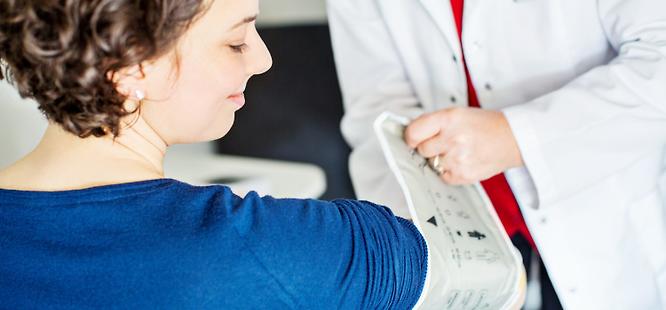
Blood Pressure Basics
Aug 09, 2022 | Family Medicine | Share:
Every time you come to the doctor, whether it’s for a broken bone, a sinus infection, or your annual checkup, your doctor’s going to want to know your blood pressure.
But have you ever wondered why those numbers are so important? And do you really know what those numbers mean?
We’re getting back to the basics with our guide to understanding blood pressure - and what you should do if yours isn’t quite where it needs to be.
What is Blood Pressure?
Blood pressure is the measure of the pressure your blood exerts against the walls of your arteries. The heart pumps blood into the arteries, and this force creates pressure. The higher the pressure, the harder your heart has to work. You want your blood to flow with just the right amount of pressure in the same way that you want water to flow through the pipes in your home: not too much and not too little.
Blood pressure is measured using a sphygmomanometer, or a blood pressure cuff, that inflates. The cuff is placed on the upper arm and measures the pressure in the arteries. The first number, called systolic pressure, measures the pressure when your heart beats. The second number, called diastolic pressure, measures the pressure when your heart relaxes between beats.
Your doctor measures your blood pressure while you're at rest. Blood pressure readings can be impacted by stress, activity, or illness.
What do the Numbers Mean?
You may be familiar with how your blood pressure numbers sound, but do you really know and understand what those numbers mean?
Blood pressure readings are given as a combination of two numbers, your systolic blood pressure reading (the top number) over your diastolic blood pressure reading (the bottom number). Blood pressure is usually written with the systolic number first, followed by the diastolic number, such as 120/80 mmHg (millimeters of mercury).
Normal blood pressure is a systolic reading of less than 120 and a diastolic reading of less than 80. If either of these numbers is higher, you have high blood pressure. High blood pressure puts extra strain on your heart and arteries and can lead to serious health problems such as heart disease, stroke, and kidney disease.
According to the American Heart Association, Stage 1 hypertension occurs when systolic pressure is between 130-139 or diastolic pressure is between 80-89. This is sometimes called prehypertension, and it can often be treated with lifestyle interventions rather than medication. (Individual treatment recommendations will vary.)
Stage 2 hypertension occurs when systolic pressure is 140 or higher, or diastolic pressure is 90 or higher. If you have consistent readings in this range, your doctor will likely prescribe both lifestyle changes and medication to lower your blood pressure.
A hypertensive crisis is a medical emergency and requires immediate treatment. This occurs when systolic pressure is 180 or higher and diastolic pressure is 110 or higher. It's also possible to have blood pressure that's too low (hypotension), but doctors usually only address this when it presents with symptoms.
How High Blood Pressure Impacts Your Life
High blood pressure doesn't usually happen overnight; it develops over time, usually due to lifestyle choices or genetics. As your heart works harder and harder to pump blood, it causes damage to your arteries. This damage causes your heart to continue to work harder to pump blood, raising your blood pressure and increasing your risk of complications.
High blood pressure often has no symptoms, which is why it is often called a silent killer. That's why it's important to see your primary care doctor regularly and monitor your blood pressure and its changes over time.
Uncontrolled high blood pressure can lead to heart attack, heart failure, aneurysm, stroke, confusion, kidney damage, and even damage to your eyes.
Some people with extremely high blood pressure may experience symptoms, including:
- Severe headache
- Fatigue
- Swelling in your feet or ankles
- Chest pain
- Difficulty breathing
- Confusion
If you're experiencing any of these symptoms and have a history of high blood pressure, you should see your primary care doctor or an urgent care doctor right away.
Fortunately, high blood pressure can be reversed. Lifestyle changes such as eating a healthy diet, exercising regularly, and managing stress can all help lower blood pressure. In some cases, medication may be necessary. Your doctor will create a treatment plan tailored to your specific medical needs.
When to See Your Doctor for Blood Pressure Issues
Any time you have concerns about your blood pressure, schedule an appointment with your primary care doctor. If you have ongoing blood pressure issues, you should be sure to establish a relationship with a primary care doctor to help you better manage your blood pressure and any needed treatments.
But if the wait is too long or if you don’t already have a primary care doctor, an urgent care doctor is a great option. Your urgent care doctor can treat you quickly and, if you need emergency treatment, we can get you to the hospital right away.
Patients with a blood pressure reading of 180/110 or higher should call 911 or go directly to the nearest emergency room.
At MedHelp Clinics in Birmingham, we offer both urgent care and relationship-based primary care. Whether you need treatment for an urgent medical need or want ongoing care from a trusted provider, we’re ready to treat you. Our urgent care clinics are open seven days a week with extended hours on weekdays, and our primary care doctors are accepting new patients at each of our five Birmingham clinic locations.
Don’t let high blood pressure go unchecked. Visit a MedHelp urgent care clinic near you if you suspect that your blood pressure is on the rise.